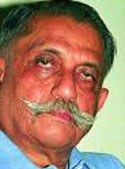
By Shankar Roychowdhury
Aug 02, 2016
Dhaka’s Gulshan is a combination of New Delhi’s Connaught Place and Diplomatic Enclave. On the evening of July 1, group of seven young men sporting checked Arab “Kaffiyeh” and armed with assorted weapons, including an AK-22, a low-cost, locally manufactured, sub-calibre “lookalike” of the iconic AK-47, stormed into the Holey Artisan Bakery. They barricaded themselves inside with hostages, including an Indian girl, selected after testing their knowledge of the sacred Kalma. All efforts at negotiation by the police were futile and finally the eliminated in an urban assault by Bangladeshi special forces which used BTR-80 armoured personnel carriers as battering rams to breach the restaurant’s walls.
When the smoke and dust finally cleared, the body count at the café was 29 dead — including six terrorists, 20 hostages and two policemen. Four of the dead terrorists were identified by the Bangladesh police counter-terrorist unit as Akash, Bikash, Don and Badhon, typical Bangla “nom des guerre” reminiscent of the violent Naxal era of Kishanji in the forests of neighbouring West Bengal. It was a scene of mindless barbarism by radicalised and ideologically unbalanced “lone wolves,” now sadly all too familiar in several cities across the globe.
The Islamic State never formally claimed responsibility for the Gulshan attack, which media reports suggested were carried out by cadres of the Jamaat-ul-Mujahideen Bangladesh (JMB) that was already on the radar of the Indian intelligence agencies over the Khagragarh bomb blasts in West Bengal’s Burdwan district in October 2014.
The ripples from the Gulshan attack will undoubtedly impact India as well, particularly West Bengal. Any major metropolis, with a dense population, crowded traffic and industrial suburbs with festering slums, smog, industrial suburbs and police forces, generally overworked, undermanned and inadequately equipped, is the ideal urban jungle, where problems of law and order are imposed on social and political unrest. In eastern India, the megapolis of Kolkata, located not too far from the Bangladesh border and with a substantial floating population of visitors from that country on business or pleasure, fits this profile admirably.
Bangladeshi criminals on the run from the police in their country have been known to exploit the densely populated concrete canyons of Kolkata as hideouts after illegally infiltrating across the porous India-Bangladesh border. This heightens the possibility of JMB members trying to seek sanctuary in West Bengal.
The security of India’s international borders is the task of the Government of India, but in practice this must be an integrated working arrangement between the Central and state governments, each having its own role to play, with the state police and intelligence agencies giving backup support to Central forces and agencies in the first tier of integrated border management. Management of the West Bengal-Bangladesh border follows the same organisational format, though in the overall perception at the national level, the threat levels across India’s eastern borders with Bangladesh are a relatively lower priority in contrast with the western and northern ones adjoining Pakistan and China.
This is not surprising as India has fought four wars with Pakistan since 1947. The focus briefly shifted eastwards during the Bangladesh operations in 1971, but the priorities were pulled back towards the western border after Russian intervention in Afghanistan in 1979 and then, much later, after America intensified its operations in the Afghanistan-Pakistan region.
The liberalism brought to Bangladesh by Sheikh Mujibur Rahman, after the victory over Pakistan in the 1971 war, was deliberately eroded after his assassination by a series of military regimes that took over and was replaced by an ultra-radicalised Wahhabi Islam, with major financial incentives for propagation of jihad provided by Islamic charities based in Saudi Arabia.
A network of mosques and madrasas have been built with Saudi funds in India too, and also, disturbingly, in the Terai belt on the sensitive India-Nepal border, where semi-literate religious clerics, “barefoot teachers,” impart Islamic diktats. These may also be bases for infiltration and espionage from Nepal into the Indian heartland.
The Gulshan attack in Dhaka by radicalised terrorists is a warning that India can ignore only at its own peril. The spread of Wahhabi Islam in Bangladesh is a danger signal to the entire subcontinent, and calls for a major politico-military “hearts and minds” effort by Sheikh Hasina and all secular elements in Bangladesh. India must continue to fully back Sheikh Hasina and her government.
Things are fluid in Bangladesh, and New Delhi must constantly review and recalibrate its policy options there, while factoring in the impact of its own internal socio-political issues in parts of India. All varieties of radical religious sentiments are equally unacceptable in the secular Indian milieu. Aberrations like violence over caste, beef-eating, and cow slaughter have the potential to metamorphose into full-blown national security crises if they are allowed to ferment unattended, supplementing other tensions in the Kashmir Valley organised by anti-national outfits like the Hurriyat and fomented by their Pakistani paymasters.
Puritanical opposition to so-called “symbols of Western decadence” like Holey Artisan Café reveals a medieval ultra-puritanical mindset that has no place in any liberal modern society.
Shankar Roychowdhury is a former Chief of Army Staff and a former Member of Parliament
Source: asianage.com/columnists/after-gulshan-watch-out-its-ripples-indian-cities-756

No comments:
Post a Comment